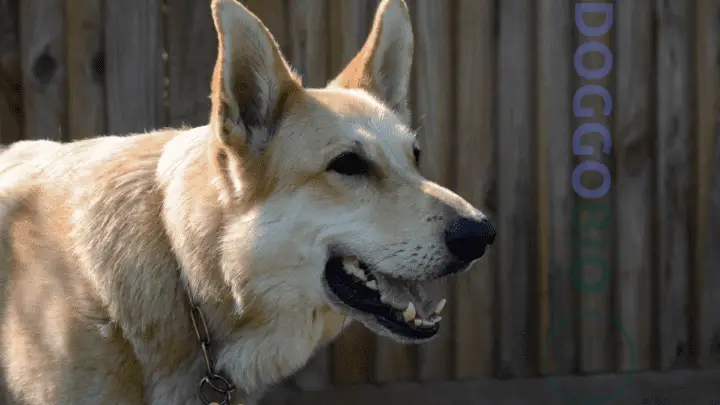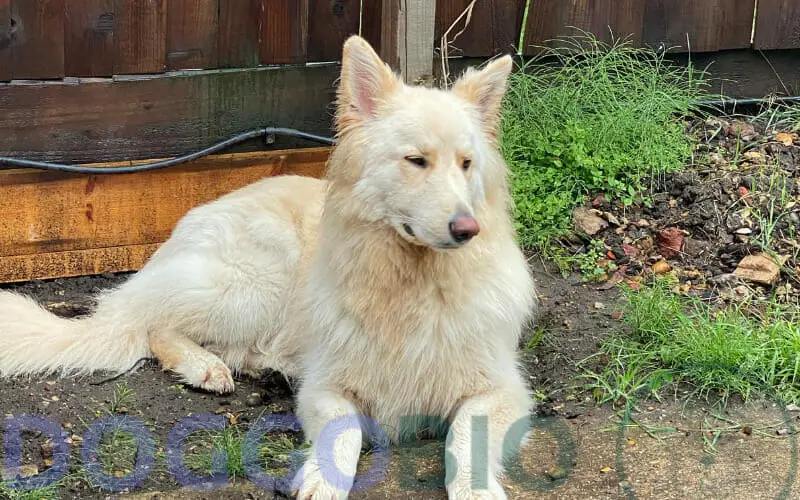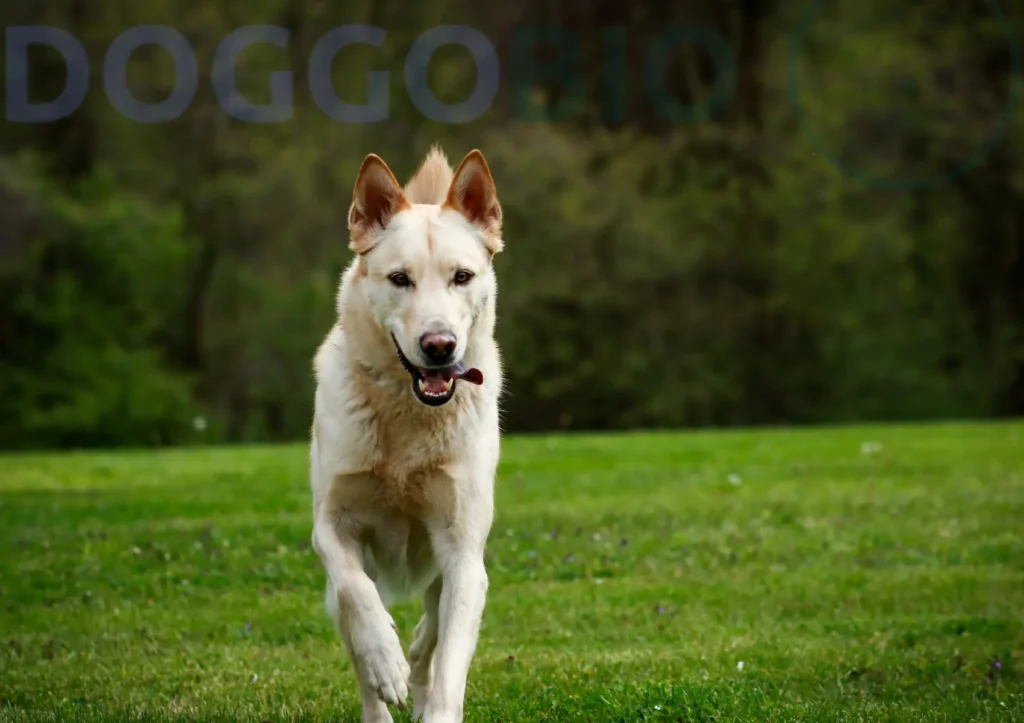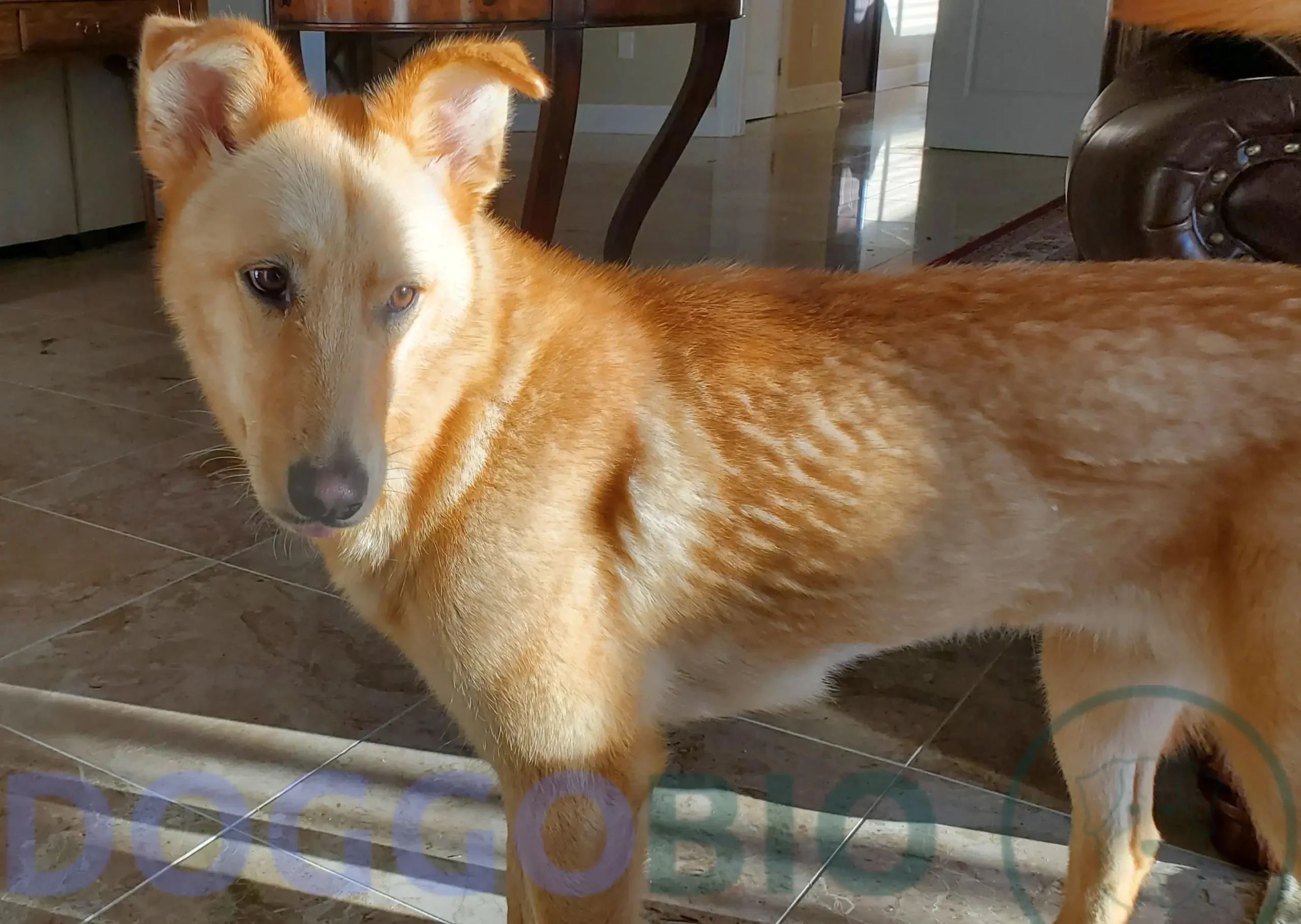The blonde German Shepherd, with its strikingly beautiful and unique appearance, stands out among the many breeds of dogs. This captivating canine possesses the same intelligence, loyalty, and versatility that are characteristic of the German Shepherd breed, yet its stunning blonde coat sets it apart from its more commonly seen black and tan counterparts.
Bred for its remarkable working abilities and gentle demeanor, the blonde German Shepherd has become a favorite among dog enthusiasts, not only for its attractive appearance but also for its impressive skills in various roles, including as a devoted family companion, a skilled working dog, and a loyal protector.
In this article, we will delve into the fascinating characteristics, history, and the exceptional qualities that make the blonde German Shepherd a beloved and cherished breed in the world of dogs.
A Brief Overview of Blonde German Shepherd
| Other Names | Black and Tan GSD, Bi-color GSD |
| Purity | Purebred dog |
| Purpose | Working dog |
| AKC Recognition | Yes |
| Size | Large |
| Weight | 50-90 pounds |
| Height | 22-26 inches |
| Coat Colors | Black and tan |
| Child Friendliness | High |
| Canine Friendliness | Low |
| Training Difficulty | Easy |
| Grooming Upkeep | Moderate |
| Exercise Needs | High |
| Health | Moderate |
| Lifespan | 9-13 years |
| Puppy Costs | $500 to $2,000 |
What Is A Blonde German Shepherd?
A Blonde German Shepherd is a unique variant of the German Shepherd breed, distinguished by its golden, cream, or yellowish coat. This rare coloration, consistent from puppyhood to adulthood, sets them apart from the traditional black and tan German Shepherds. While they share the same physical traits as standard German Shepherds, their distinctive color makes them a standout.

It’s interesting to note that some German Shepherd puppies may initially appear light-colored, resembling blondes, but as they grow, their coat often changes to the breed’s classic black and tan, adding an element of surprise to their development.
What Is The Genetic Color Of The German Shepherd’s Coat?
The fascinating genetics behind the Blonde German Shepherd coat color revolve around the pheomelanin pigment, responsible for the red hues.
While not entirely clear, geneticists believe that a recessive gene could interact with the gene for red color, diluting it into a cream shade, resulting in the delightful light Blonde German Shepherd we admire.
Interesting Facts about Blonde German Shepherds

1.Ever-changing Coats
While some blonde German Shepherds retain their color throughout their lives, it’s fascinatingly familiar for these dogs to darken with age.
Don’t be surprised if your adorable blonde puppy transforms into a tan or brown beauty as they mature. Occasionally, you might even witness a puppy you thought was white turning into a stunning blonde as time passes, although such instances are relatively rare.
2.The Mystery Behind Their Origin
When it comes to the enchanting blonde German Shepherds, the exact combination of coat genes from their parents that gives rise to their lovely color remains a puzzle.
Despite this lack of clarity, it’s intriguing to know that blonde coats can unexpectedly appear in various breeding programs, including those that uphold responsibility and integrity. Some speculate that the gene linked to red coats might play a role in creating these captivating blondes.
3.Exquisite Rarity
Blonde German Shepherds are undeniably a sight to behold, and their scarcity adds to their allure. Their exceptional rarity can be attributed to two main factors.
- Firstly, the mystery surrounding the exact genes responsible for their distinctive coat color contributes to the challenge of breeding them intentionally.
- Secondly, misconceptions among some people, who mistakenly consider them as mixed breeds, have led many responsible breeders to shy away from incorporating light-colored dogs into their programs.
As a result, encountering these enchanting blonde beauties is an extraordinary and cherished occurrence.
4.A Unique and Misunderstood Hue
The blonde coat of German Shepherds stands as a distinct color, often confused with other shades such as albino, white, golden, or cream. However, it’s essential to clarify that blondes are in a class of their own. Albino is an entirely separate coloration, and each of the mentioned hues has its unique characteristics, separate from the captivating blonde coat color.
Blonde German Shepherds possess melanin, giving rise to various eye colors, including brown, black, or tan. Additionally, their nose and paw pads tend to display darker hues, usually in shades from tan to black.
5.Discovering the True Heritage
Although blonde can be a legitimate coat color in German Shepherds, as we’ve previously explored, it remains infrequent. If you encounter a dog resembling a blonde German Shepherd at a shelter, rescue, or through less reputable breeders, it’s likely a mixed breed. But fear not, doggy DNA tests can come to your aid in unraveling the pup’s true genetic background, verifying if it’s a purebred German Shepherd or a delightful mix.
To ensure you’re dealing with a bona fide full-blooded blonde German Shepherd, opting for reliable breeders who conduct health tests and produce high-quality dogs.
6.Healthy and Carefree
The genes responsible for the captivating blonde coat in German Shepherds don’t come with any specific health concerns. Unlike color breeding, which can compromise the well-being of the offspring by ignoring underlying health conditions in the parents, the accidental emergence of blonde German Shepherds does not increase their risk of medical issues compared to other coat types.
What Does A Blonde German Shepherd Look Like?
A blonde German Shepherd exhibits a stunning mix of colors, primarily featuring a creamy base with darker golden streaks enhancing their appeal. Their coat color resembles the rich hues of a yellow Labrador or Golden Retriever.

Beyond their captivating blonde coat, they retain the classic traits of the German Shepherd breed, including a black nose, paw pads, and typically deeper-toned eyes.
This unique coat color distinguishes them, yet they embody all the esteemed qualities of the German Shepherd breed.
Size, Height, and Weight
The size, height, and weight of Blonde German Shepherds can vary, but there are general trends to consider:
German Shepherds usually reach their full height at around 18 months of age. Male German Shepherds are typically slightly larger than females.
While individual variations exist, here is a rough estimate of their growth chart:
| Age | Height (Males) | Weight (Males) | Height (Females) | Weight (Females) |
| 3 months | 9 – 11 inches | 22 – 30 pounds | 8 – 10 inches | 17 – 25 pounds |
| 6 months | 16 – 18 inches | 49 – 58 pounds | 15 – 17 inches | 44 – 50 pounds |
| 9 months | 21 – 23 inches | 64 – 70 pounds | 19 – 21 inches | 55 – 60 pounds |
| 12 months | 22 – 24 inches | 71 – 75 pounds | 20 – 22 inches | 60 – 64 pounds |
| 18 months | 23 – 25 inches | 76 – 100 pounds | 21 – 22 inches | 65 – 90 po |
It’s essential to remember that these figures are approximate and individual dogs may fall outside these ranges. Proper nutrition, exercise, and regular veterinary care are vital to ensure that these magnificent canines grow and develop healthily.
Temperament and Personality
Blonde German Shepherds embody the breed’s esteemed traits – loyalty, courage, alertness, and a strong work ethic. They are sensitive and prone to separation anxiety if left alone too long.
As family pets, they are protective and loyal, thriving with early socialization, especially around children. They may be reserved around unfamiliar animals, but early exposure helps.
Overall, they are devoted, dependable companions, excelling as both protectors and loyal family members.
Training and Exercise Requirements
Training a Blond German Shepherd is usually a breeze, thanks to their high intelligence. These dogs have an exceptional work ethic and take pride in fulfilling their duties, especially when they receive regular training and mental stimulation. However, insufficient mental and physical activities can result in unwanted behaviors such as excessive barking or continuous digging in the yard.

To keep an adult Blond German Shepherd content and well-behaved, at least 90 minutes of daily exercise is essential. Running or jogging are ideal activities, as these dogs are highly active and thrive on physical challenges. Neglecting their exercise needs could lead to boredom and anxiety, possibly manifesting as destructive or aggressive behaviors.
Grooming and Cleaning
- Keeping your Blond German Shepherd’s coat in top condition requires regular grooming. Due to their thick fur, frequent brushing is essential to remove excess hairs and evenly distribute natural oils from their neck to tail.
- When it comes to bathing, do so sparingly to prevent skin dryness and allow the natural oils to work their magic. When bath time does arrive, opt for a dog shampoo that not only cleans but also promotes a healthy and moisturized skin and coat.
- To maintain their ear health, make it a habit to check their ears regularly for any signs of infection or irritation.
- Oral hygiene is equally important, and your furry companion’s teeth should be brushed two to three times a week with dog-friendly toothpaste. Alternatively, disposable dental wipes can also be used for cleaning their teeth.
By incorporating these grooming and cleaning practices into your routine, you’ll ensure your Blond German Shepherd looks and feels their best, promoting their overall well-being and happiness.
| Grooming Task | Recommended Frequency |
| Brushing | Daily |
| Bathing | Once a month |
| Ear cleaning | Weekly |
| Nail trimming | Every 2-4 weeks |
| Teeth brushing | 2-3 times a week |
| Coat trimming | Every 6-8 weeks |
| Eye cleaning | As needed |
| Paw pad care | Monthly |
Food and Diet
When it comes to feeding your Blond German Shepherd, several factors come into play, including their activity level, age, and size. For most adult German Shepherds, around 2 cups of high-quality dog kibble per day is typically sufficient. To ensure proper digestion and reduce the risk of bloating and stomach torsion, it’s best to split the daily amount into two meals.
Being mindful of your furry friend’s dietary needs and providing them with balanced, nutritious meals will help keep them in excellent health and maintain their active lifestyle. Always consult with your veterinarian to determine the best feeding plan for your individual Blond German Shepherd.
Life Expectancy and Common Health Issues
While German Shepherds are generally considered one of the healthiest dog breeds, it’s essential to be aware of potential health issues that can affect them:

- Hip Dysplasia: Larger dogs, including German Shepherds, can be prone to hip dysplasia, a condition where the hip joints are loose or improperly aligned.
- Gastric Dilatation-Volvulus (GDV): Also known as bloating, this condition occurs when the stomach fills with gas, causing it to twist.
- Canine Degenerative Myelopathy: This is a degenerative disease that affects the spinal cord and can impact your dog’s mobility.
- Hypothyroidism: A condition where insufficient thyroid hormones are produced, leading to lethargy, weight gain, and hair loss.
- Osteoarthritis: This degenerative disorder involves inflammation of the joints due to cartilage deterioration.
Blonde German Shepherds have an average lifespan of 9 to 13 years, with females typically living at least one year longer than males on average. Regular veterinary check-ups and a healthy lifestyle can help mitigate potential health concerns and ensure your furry friend enjoys a long and happy life.
How Much Is A Blonde German Shepherd?
You can expect to pay between $1,000 to $2,000 from reputable breeders for these precious pups. Although occasionally, luck may favor you, and you might come across one at a more affordable price range of $500 to $1,000. Nevertheless, the price is a testament to their uniqueness and the value they bring to your life as cherished companions.
How Can I Find a Blonde German Shepherd For Sale?
When looking for a Blonde German Shepherd breeder, it’s crucial to prioritize ethical, responsible, and reputable ones. Steer clear of purchasing from puppy stores, as the source of these pups is often unknown, and supporting puppy mills should be avoided at all costs.
Reputable breeders will gladly welcome potential buyers to visit their kennels and see the conditions firsthand. They will also provide proof of health certificates for their dogs, demonstrating their commitment to the well-being of their animals. Additionally, responsible breeders often have their puppies microchipped before they are released to their new owners, ensuring added security and identification for the pups.
Taking the time to find a trustworthy breeder will not only result in a healthy and well-cared-for Blonde German Shepherd but also contribute to the welfare of dogs and the breeding community as a whole.
List of dogs that are similar to Blonde German Shepherd
- German Shepherd-Chihuahua Mix
- German Shepherd-Cane Corso Mix
- German Shepherd-Catahoula Mix
- German Shepherd-Poodle Mix
- German Shepherd-Shiba Inu Mix
- German Shepherd-Greyhound Mix
Frequently Asked Questions
Are Blonde German Shepherds Purebred?
Yes, indeed! Blonde German Shepherds are genuine members of the German Shepherd breed. While their appearance might deviate from the classic tan and black dogs we often associate with this breed, their purebred status remains unchanged.
The subtle variation in their coat color results from a minor genetic difference, but in all other aspects – physically and mentally – these dogs possess the same genetic makeup as other German Shepherds.
Does AKC Recognize Blonde German Shepherds?
Kennel clubs, such as the AKC, recognize that blonde German shepherds are purebred dogs. However, they do not officially accept them as a recognized coat color for the breed.
Consequently, blonde German Shepherds cannot participate in competitions or shows with official sanctioning. This fact prompts owners and breeders, particularly those focused on show dogs, to steer clear of blondes.
Yet, this doesn’t mean that blonde German Shepherds are excluded from all competitions. While they might not be eligible for shows based on purebred characteristics, they can still participate in contests highlighting their physical prowess and agility skills.
Are Blonde German Shepherds Rare?
Yes, Blonde German Shepherds are considered rare due to the intricate probability of combining two uncommon genetic mutations to create an all-Blonde German Shepherd.
Additionally, breeders often hesitate to focus on rare coat colors in German Shepherds, as such variations are not accepted in dog shows.
What Is The Rarest Color Of German Shepherd?
Among German Shepherds, Isabella is considered the rarest color, and it’s a captivating light lavender hue. Alongside Isabella, fawn and liver are also recognized as rare coat colors for this breed. These unique color variations add a touch of rarity and allure to the already magnificent German Shepherd.
Are Blonde German Shepherds Hypoallergenic?
No, Blonde German Shepherds are not hypoallergenic, and it’s essential to be aware of this if you or someone in your household has allergies.
These dogs shed consistently throughout the year and experience heavy shedding twice a year, typically during spring and fall. Regular grooming and cleaning are necessary to manage their shedding and keep allergens under control.
Do German Shepherds Change Color As They Grow?
Yes, blonde German Shepherd puppies can darken as they get older.
The coat color of blonde German Shepherds is known to change as they age. It is a relatively common occurrence for their coats to become darker over time. The exact reasons behind These color changes are not entirely understood but could be influenced by genetic, pigment-related, dietary, health, and environmental factors.
While there is no surefire way to predict how much their coats will darken or the specific timeline for these changes, it is possible for blonde German Shepherds to transition into a darker golden yellow or even a light brown shade as they mature.
What Is The Difference Between A Blonde And A White German Shepherd?
While both are distinct color variations within the German Shepherd breed, they exhibit significant differences in their coat coloring.
- White German Shepherds possess a pristine white coat resembling freshly fallen snow’s brilliance, remaining entirely white throughout their bodies.
- On the other hand, blonde German Shepherds showcase a captivating cream hue, darker and more textured than their counterparts’ pristine white. The cream shade is the prominent color that covers most of their body, often complemented by streaks of a deeper golden color, adding to their unique and alluring appearance.
Is An Albino German Shepherd The Same As Blonde GSD?
No, Blonde GSD is not equivalent to Albino GSD. These two German Shepherds possess distinct genetic characteristics that determine their coloration.
- Albino German Shepherds are entirely white and lack any pigmentation, resulting in their signature pale appearance. They have pink noses and eyelids, typical traits found in animals with albinism.
- In contrast, Blonde German Shepherds boast captivating Blonde coats, which result from a dilution of the gene responsible for the red coloration. Their unique hue sets them apart as a rare and stunning variation within the German Shepherd breed.
Can A German Shepherd Be A Working Dog?
Absolutely! Blonde German Shepherds can be excellent working dogs due to their intelligence and adaptability to training. They love having a job to do and thrive when mentally stimulated. However, their rarity often makes them more likely to be treasured as pets rather than employed as working dogs.
Conclusion
In conclusion, the blonde German Shepherd is a striking and versatile breed, combining beauty and intelligence in a captivating manner. Its history as a skilled working dog and its gentle, loyal nature make it a beloved companion for families and individuals alike.
Whether in the field or at home, this exceptional canine continues to earn its place in the hearts of dog enthusiasts worldwide.

Pingback: Cane Corso German Shepherd Mix: Dynamic Crossbreed 2024
Pingback: Catahoula German Shepherd Mix: Rare Breed's Majestic 2024
Pingback: German Shepherd Greyhound Mix: Graceful Fusion 2024